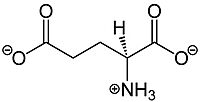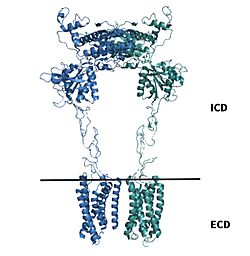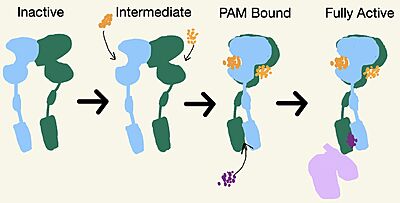Sandbox Reserved 1703
From Proteopedia
(Difference between revisions)
| Line 25: | Line 25: | ||
===PAM and NAM Bound Form=== | ===PAM and NAM Bound Form=== | ||
| - | Moving from the intermediate state, a second glutamate will bind in the other lobe of the VFT. This will help close the VFT and move the CRD closer together <ref name="Seven" />. A positive allosteric modulator (PAM) or a negative allosteric modulator (NAM) will then come in and bind to mGlu2. PAM and NAM induce different conformational changes, which result in different outcomes. <scene name='90/904308/Pam/4'>PAM binds</scene> the TMD and promotes greater affinity for the binding of the G-protein. There are different types of PAMs that can bind to the TMD but this page focuses on JNJ-40411813<ref name="Lin"/>. PAM binds in a binding pocket that is created by helices 3, 5, 6, and 7 in the <scene name='90/904307/Tmd_helices/ | + | Moving from the intermediate state, a second glutamate will bind in the other lobe of the VFT. This will help close the VFT and move the CRD closer together <ref name="Seven" />. A positive allosteric modulator (PAM) or a negative allosteric modulator (NAM) will then come in and bind to mGlu2. PAM and NAM induce different conformational changes, which result in different outcomes. <scene name='90/904308/Pam/4'>PAM binds</scene> the TMD and promotes greater affinity for the binding of the G-protein. There are different types of PAMs that can bind to the TMD but this page focuses on JNJ-40411813<ref name="Lin"/>. PAM binds in a binding pocket that is created by helices 3, 5, 6, and 7 in the <scene name='90/904307/Tmd_helices/9'>asymmetric TM3-TM4 interface</scene> . Within helix 6, the hydrophobic binding is composed of W773, F776, L777, and F780. Due to spatial hindrance caused by the binding of PAM, helix 6 is shifted downward, causing reorientation of the TMD. This reorientation creates a cleft in the TMD for the G-protein to bind<ref name="Lin"/>. NAM, however, reduces the affinity for G protein binding. <scene name='90/904308/Nam_bound/2'>NAM binds</scene> to the same binding pocket as PAM and also interacts with residue W773, but NAM occupies the binding site a little deeper than PAM. This causes NAM to push the side chain of W773 towards helix 7, which does not form the cleft for G-protein binding<ref name="Lin"/>. |
[[Image:PAM binding pocket correct.png |300px|right|thumb|'''Figure 4.'''PAM binding pocket. PAM, JNJ-40411813, is shown in magenta and colored by atom type, four labelled binding helices (3, 5, 6, and 7) create the binding pocket in the 7TM region for PAM binding. PAM binding promotes G-protein activation by mGLu2.]] | [[Image:PAM binding pocket correct.png |300px|right|thumb|'''Figure 4.'''PAM binding pocket. PAM, JNJ-40411813, is shown in magenta and colored by atom type, four labelled binding helices (3, 5, 6, and 7) create the binding pocket in the 7TM region for PAM binding. PAM binding promotes G-protein activation by mGLu2.]] | ||
Revision as of 04:55, 19 April 2022
α=Metabotropic Glutamate Receptor 2=
| |||||||||||
3D Structures
7mtq, mGlu2 inactive
7mtr, mGlu2 PAM bound
7mts, mGlu2 active
References
- ↑ 1.00 1.01 1.02 1.03 1.04 1.05 1.06 1.07 1.08 1.09 1.10 1.11 1.12 1.13 Lin S, Han S, Cai X, Tan Q, Zhou K, Wang D, Wang X, Du J, Yi C, Chu X, Dai A, Zhou Y, Chen Y, Zhou Y, Liu H, Liu J, Yang D, Wang MW, Zhao Q, Wu B. Structures of Gi-bound metabotropic glutamate receptors mGlu2 and mGlu4. Nature. 2021 Jun;594(7864):583-588. doi: 10.1038/s41586-021-03495-2. Epub 2021, Jun 16. PMID:34135510 doi:http://dx.doi.org/10.1038/s41586-021-03495-2
- ↑ 2.0 2.1 2.2 Seven, Alpay B., et al. “G-Protein Activation by a Metabotropic Glutamate Receptor.” Nature News, Nature Publishing Group, 30 June 2021, https://www.nature.com/articles/s1586-021-03680-3
- ↑ Du, Juan, et al. “Structures of Human mglu2 and mglu7 Homo- and Heterodimers.” Nature News, Nature Publishing Group, 16 June 2021, https://www.nature.com/articles/s41586-021-03641-w.>
- ↑ 4.0 4.1 “Metabotropic Glutamate Receptor.” Wikipedia, Wikimedia Foundation, 27 Mar. 2022, https://en.wikipedia.org/wiki/Metabotropic_glutamate_receptor
- ↑ 5.0 5.1 \“Schizophrenia.” National Institute of Mental Health, U.S. Department of Health and Human Services, https://www.nimh.nih.gov/health/topics/schizophrenia
- ↑ 6.0 6.1 Ellaithy A, Younkin J, Gonzalez-Maeso J, Logothetis DE. Positive allosteric modulators of metabotropic glutamate 2 receptors in schizophrenia treatment. Trends Neurosci. 2015 Aug;38(8):506-16. doi: 10.1016/j.tins.2015.06.002. Epub, 2015 Jul 4. PMID:26148747 doi:http://dx.doi.org/10.1016/j.tins.2015.06.002
- ↑ 7.0 7.1 7.2 7.3 Muguruza C, Meana JJ, Callado LF. Group II Metabotropic Glutamate Receptors as Targets for Novel Antipsychotic Drugs. Front Pharmacol. 2016 May 20;7:130. doi: 10.3389/fphar.2016.00130. eCollection, 2016. PMID:27242534 doi:http://dx.doi.org/10.3389/fphar.2016.00130
Student Contributors
Frannie Brewer Ashley Wilkinson




